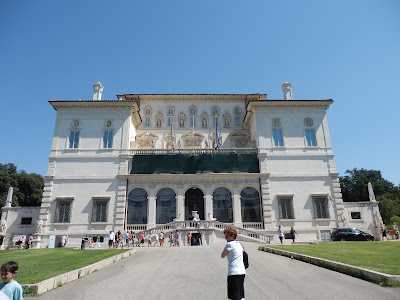I forgot, when they forbid you to take your camera in there is usually a reason. On the outside it is a small unassuming little villa, lightly dotted with busts of important Romans, but on the inside, it was breathtaking (literally). Every public room was panelled in varicoloured marble, and these walls merged with the ceiling in a cornicopia of colours and symbols. Even when you had recovered from the overwhelming sight, there was still too much to revel in every detail. And this was just the public rooms; In the more private rooms, the walls at least were plain but you could have lain in bed staring all day at the ceilings or the famous paintings that hung around you. Unfortunately I haven’t been able to find any books that replicate the art collection or rooms to satisfaction.
Here, there was a delightful reference to the current location of some of the collection. In Athens they refer to Lord Elgin stealing the marbles, in Villa Borghese it is more diplomatically described as ‘the emigration of the marbles’. It seems Camillio Borghese sold 304 pieces of his collection to his brother-in-law (Napoleon) for something like 13 million francs. This included the rather superb Hermaphroditus now reclining in the Louvre along with several other pieces the Louvre is unwilling to return. As a result there is now a legal clause attached to the gallery which forbids the collection from being broken up any further.

No comments:
Post a Comment